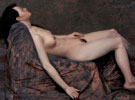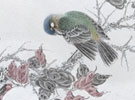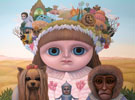Objects' carrousel
The original spontaneity must become something more complex, now that those works become the 'real thing', no longer a hymn to horticulture or to pure fun. Sizes expand, a rich variety of gorgeous vegetables are juxtaposed in the same long scroll (up to four meters). Less empty space is left, dozens of vegetables are either placed orderly side by side or amassed together, although they are spread out in a bi-dimensional space that never tends to attain the third dimension.
At one point Li Jie either must have got bored with the vegetables, or maybe she needed to do some restoration work in her new living space and had to purchase a certain quantity of screws and nails. Whatever the reason might be, she started to draw these objects. The result is very different from the previous: whereas vegetables possess organic forms, each one being very unique, having peculiar textures and rounded lines, men made objects are mainly characterized by straight lines, perfectly geometric forms, and uniformity of appearance. I am quite sure Li Jie has perceived these fundamental differences right away: screws, nails, wires... are amassed in a crowded space that leaves no breath. Here one does not think of the painter's enjoyment, confronted with a colorful amount of beans and tubers; rather, one imagines the drawing process as more similar to an automatism, and this difference resembles the one existing between the work of a peasant, who changes task many times a day, and a factory worker at the assembly line, repeating endlessly the same movement. These amasses of screws, of nails, of bicycle chains, make us think - feel - sense - the obsessive rhythm of working in a factory - be it Luoyang's "First tractor's factory' (where Li Jie was employed in early days) or any other.
The viewer is taken prisoner by a suffocating amass of things, to the point that she/he feels like being swallowed by them. Differently from traditional Chinese painting, where it is the viewer's imagination that makes her/him enter the painting creatively so to 'fill the voids', here we sink in an abyss without space for breath and thought. It is true that both the vegetables and those nails - buttons - screws - wires are part of everyday life. But they allude to very different lifestyles. My personal taste - not contemporary and not trendy, I know - goes for the 'organic' world. The reason is not only ethic but very painterly too: I feel that Chinese brush and ink perform at their best when they trace lines variable in thickness, when they can be used to their greater possibility, that is to portray 'life'.
There are scrolls (this oblong size has become lately the artist's favorite) that contain a great variety of those objects that end up filling everyone's house, necessary or superfluous, disregarding their formal beauty, elegance, quality. We see bottles, slippers, note blocks, brushes, clips... and the feeling is to have been dipped into the very heart of a dumping ground. All of a sudden we are faced with the squalid sloppiness of the objects that populate our houses and engage our eyes daily.
Other paintings' subjects are inspired by more specific items, for instance electronic-related, such as mobile phones, calculators, computer components. They make me think of the photos taken by some Chinese artists few years ago, although these works obviously go through a very different and more subjective process, the one of translating a sea of solid, concrete objects into fine grey lines that intersect one into the other.
A world of lines
I have been sent the most recent works, those that will be shown in the forthcoming exhibition in Shanghai. I have to sharpen my eyes and twist my neck to examine them in the computer - unfortunately I won't be able to see the original pieces before writing about them. There is one of an impressive size, 80cmX350 cm, entitled 'threads', and 'lines', as in Chinese these two are expressed by the same word, 'xian线'. When specifically referring to drawing, though, 'xian' may become 'xiantiao线条'.
I feel that here Li Jie has regained a more natural and comfortable painting pleasure, as she has looked for any kind of thread or wire she could find in the market, and has then enjoyed the process of adapting her brush to all those different textures. Besides that, the fact that every single line is curved enables the brush, skillfully handled, to fully display its rich expressive possibility. This looks like a jungle, rather than like a rubbish bin: inorganic, 'dead' objects like threads and wires become alive thanks to the supple work of hand and wrist. I much prefer those works where the painterly skills are fully exercised, rather than those where repetitive and stiff items fill every corner to suffocation.
Li Jie has recently created different visual forms, such as one painting (60cm x 130 cm) where she has disseminated buttons along a line in an irregular shape that leaves much emptiness around. It is a rather successful way to combine imagination and automatism.
The 'sofa' and 'quilt' subjects, as far as I can see from the reproductions, do not take much advantage from the traditional Chinese technique of rendering clothes and materials with simple yet forceful brushstrokes. The quilt's wavy surface resembles mountains finely sketched out of a myriad of fine lines; the more complex the composition, the more effective the visual result.
As a suggestion to the painter, I wish she can chose to pick up the brush in moments when she does it with authentic joy and pleasure, being rapt in the process of following and reproducing the unpredictable fluidity of lines and silhouettes. That lively feeling will then be conveyed through the painting to the eye and soul of the viewer. No need to find an artificial, conceptual justification to this enjoyment.
Monica Dematté
Vigolo Vattaro, February 12th, 2011










